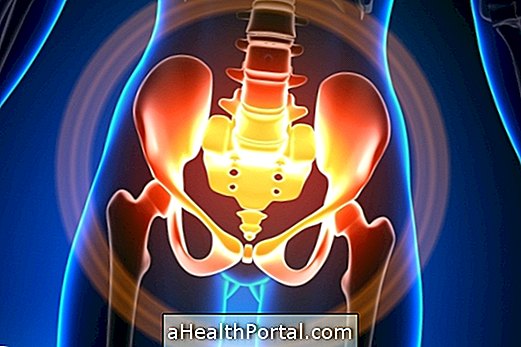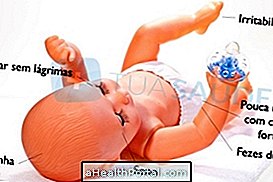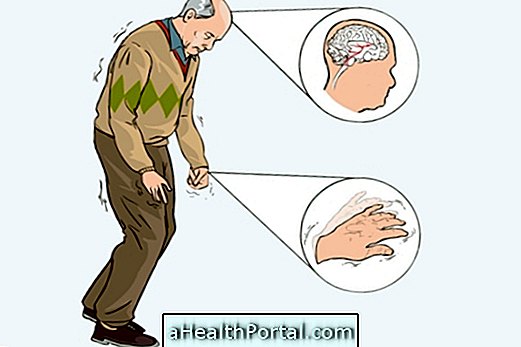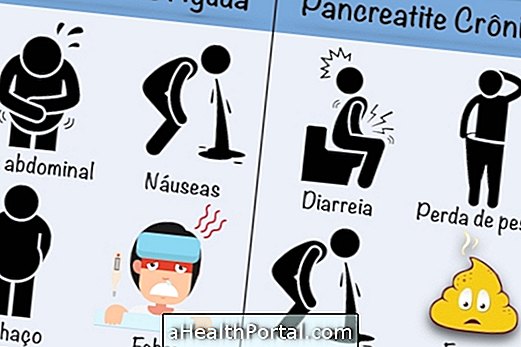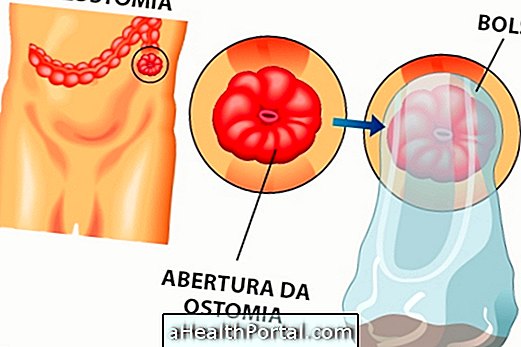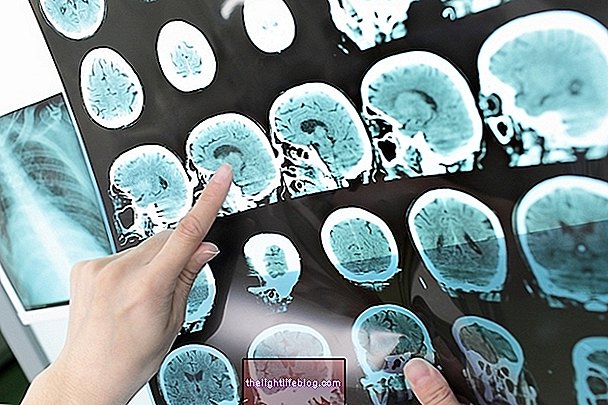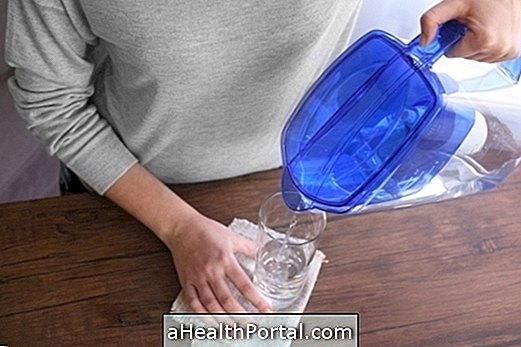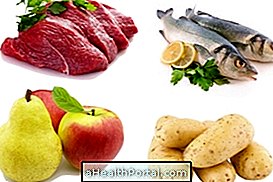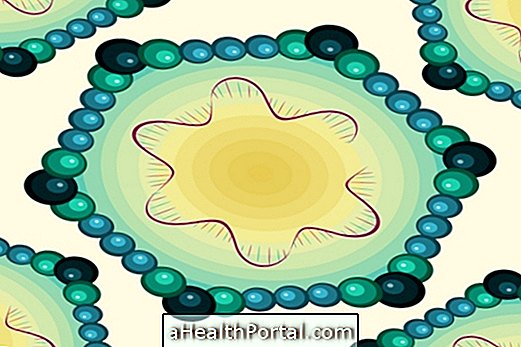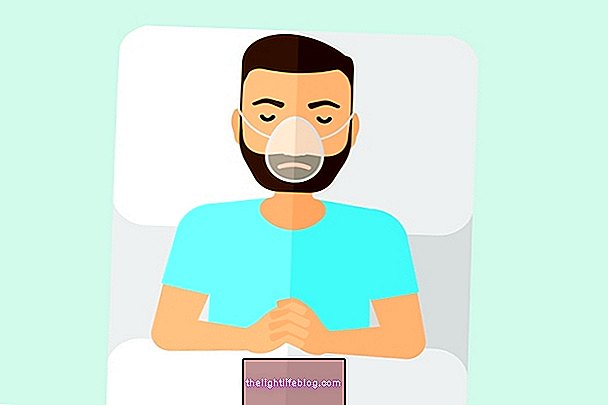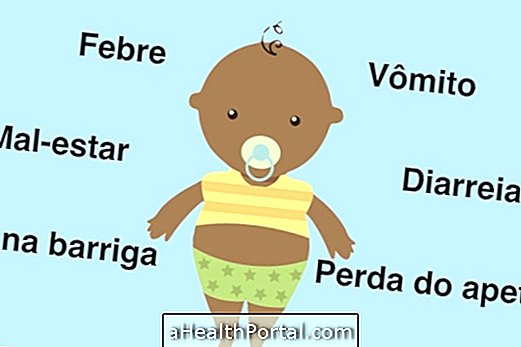There are several causes for the pain that is located in the navel region, mainly by intestinal alterations, ranging from distension by gases, contamination by worms, to diseases that cause infection or abdominal inflammation, such as gastroenteritis, appendicitis, irritable bowel or intestinal obstruction, for example.
Pain in the navel can also happen by irradiating the pain of other organs of the abdomen, due to situations such as pancreatitis and cholecystitis, or even changes caused during pregnancy, and may manifest itself in different ways, such as a colic, a persistent or accompanied by other symptoms such as vomiting, sweating and pallor.

Thus, to better differentiate the possible causes of pain in this region, it is important to undergo an evaluation of the general practitioner or gastroenterologist, who can differentiate between the main causes:
1. Umbilical hernia
The hernia is a cause of pain that arises and is located directly in the navel, and happens when a part of the intestine or other abdominal organ goes beyond the lining of the abdomen and accumulates between the muscles and skin of the region.
Generally, pain appears or worsens when exerting efforts, such as coughing or carrying weight, but may be persistent or become intense when there is a strangulation of tissues located in the hernia with intense local inflammation.
What to do : the hernia treatment is guided by the general surgeon, which can be from observation, since in some cases it can regress alone, or surgery for correction. Understand better what is and how to treat umbilical hernia.
2. Constipation
Constipation is an important cause of abdominal pain in the navel region, as it is common for distension of the intestine caused by accumulated gas or feces to stimulate the nerves passing through the region.
What to do : avoid constipation, with a high fiber diet, present in vegetables and grains, in addition to moisturize with at least 2 liters of water per day, are important to maintain a balanced bowel rhythm and without cause abdominal bloating. Laxative medications, such as Lactulose, may be given by the general practitioner if it is difficult to improve. Check out some tips to combat constipation.
3. Pregnancy
The pregnant woman may experience pain or discomfort in the navel at any time during pregnancy, which is normal and happens because the growth of the belly distends the fibrous ligament of the abdomen that is inserted in the navel, situation that weakens the wall of the navel and can provoke an umbilical hernia.
In addition, the compression and distension of the uterus and other abdominal organs can stimulate the nerves of the region and cause the sensation of navel pain, being more intense at the end of the pregnancy.
What to do : If the pain is mild or bearable, it is only possible to observe, since it tends to disappear on its own, but if it is difficult to bear, the obstetrician may indicate the use of analgesics such as Paracetamol. In addition, signs of redness, swelling or secretion in the navel should be observed, which may indicate an infection or if the pain becomes severe. Understand better about the possible causes of navel pain in pregnancy and what to do.
4. Gastroenteritis
Diarrhea that occurs from gastroenteritis or food poisoning, for example, may be accompanied by pain around the navel, although it may arise in any region of the abdomen, due to the inflammation that arises in this situation.
The pain can be accompanied by nausea, vomiting and fever, lasting on average from 3 to 7 days.
What to do : You should prefer a light, easily digestible, low-fat, grainy diet, and keep yourself hydrated with water, teas, and juice. Analgesic and anti-spasmodic medications, such as Dipyrone and Hyoscine, may be used to relieve pain, but if the symptoms become severe, last longer than 1 week, or accompanied by bleeding or fever above 39 ° C, it is important to go to the ER medical evaluation.
Check out some nutritionist tips to make diarrhea go faster:

5. Appendicitis
Appendicitis is the inflammation of the appendix, a small attachment that is attached to the large intestine, which initially causes pain around the navel and migrates to the lower right region of the abdomen, becoming more intense after a few hours. This inflammation is also accompanied by nausea, vomiting, loss of appetite and fever, in addition to the characteristic worsening of pain with abdominal decompression, after tightening and loosening specific points of the abdomen.
What to do : In the presence of symptoms indicate this disease, it is necessary to go to the emergency room for the doctor to make an assessment and make the correct diagnosis. If confirmed, treatment of this disease is done through surgery and antibiotic use. Understand better how to identify and treat appendicitis.
6. Cholecystitis
It is inflammation of the gallbladder, which usually happens by the accumulation of stones that prevent the bile out, and causes abdominal pain and vomiting, which worsen after eating. Most often, a pain occurs in the upper right region of the abdomen, but it can also be felt in the navel and radiate to the back.
What to do : In the case of symptoms that indicate this inflammation, it is important to go to the emergency room for medical evaluation and testing. The treatment is indicated by the doctor, and can be done with antibiotics, changes in feeding, hydration by the vein and the accomplishment of surgery for removal of the gallbladder.
Irritable Bowel Syndrome
This disease is characterized by abdominal pain that improves after evacuation, and is more common in the lower part of the belly, but can vary and arise in any region. It is usually associated with bloating, intestinal gas and alternating bowel habits between diarrhea and constipation.
What to do : the confirmation of this syndrome is done by the gastroenterologist, who can guide the treatment with analgesic and antispasmodic medicines to relieve pain, simethicone to reduce gas, laxatives for periods of constipation and fibers and antidiarrheals for periods of diarrhea. It is common for this disease to appear in anxious people, it is recommended to seek psychological support and decrease stress. Find out if and how to treat irritable bowel syndrome.

8. Pancreatitis
Pancreatitis is a serious inflammation of the pancreas, the main organ responsible for digestion of nutrients in the intestines, which causes severe pain in the central region of the abdomen, which can radiate to the back and be accompanied by nausea, vomiting and fever.
It can be acute, in which these symptoms are more evident, or chronic, when the pain is lighter, persistent, and there are changes in the absorption of food. As pancreatitis can become severe, in the presence of these symptoms, one should seek medical attention immediately.
What to do : In the case of symptoms that indicate pancreatitis, a medical evaluation is necessary, which may confirm the presence of this disease, and indicate the correct treatment, made with dietary restrictions, hydration in the vein and antibiotics and analgesic medicines. Only in severe cases and with complications, such as perforation, may be indicated surgical procedure. Understand better how to identify and treat acute and chronic pancreatitis.
9. Inflammatory bowel disease
Inflammatory bowel disease, characterized by Crohn's disease or ulcerative colitis, is the chronic inflammation of the lining of the intestines, an autoimmune cause. Some of the symptoms that these diseases can cause include abdominal pain, which can occur anywhere, although it is more common in the lower abdomen, diarrhea and intestinal bleeding.
What to do : The treatment of this disease is guided by the gastroenterologist, with medicines to relieve the pain and to calm inflammation and diarrhea. In more severe cases, surgical intervention may be indicated to remove portions of the intestine that may have been affected and damaged by the disease. Understand Crohn's disease and ulcerative colitis better.
10. Intestinal ischemia
Changes in blood flow to the intestine, caused by diseases such as acute ischemic disease, chronic or venous thrombosis, for example, cause abdominal pain, which can be localized in the navel due to inflammation and tissue death due to the absence of blood, and which may be sudden or persistent, depending on the cause and the affected blood vessel.
This situation can arise due to atherosclerosis of the intestinal blood vessels, or other situations such as spasm of the vessels, sudden drop in pressure, heart failure, intestinal cancer or by side effect due to drug use, for example.
What to do : The treatment of intestinal ischemia depends on the cause, guided by the gastroenterologist, usually with food control and the use of analgesic remedies, and may be indicated the use of drugs to dissolve the clot, to improve blood flow or surgery for removal of clots or part of the inflamed bowel.

Other possible causes of navel pain
In addition to the main causes, navel pain can also be caused by less common situations, such as:
- Infection by worms, which can cause inflammation and abdominal distension, and provoke pictures of umbilical pain or anywhere else in the abdomen;
- Abdominal tumor, which can distend or compress organs of the region;
- Gastric ulcer, which causes intense inflammation;
- Urinary infection, which although usually causes pain in the lower abdomen, can cause irritation of nerves near the navel, especially during the act of urinating;
- Swollen inflammation or abdominal muscles infection ;
- Intestinal obstruction, by impacted stools, neurological diseases or a tumor;
- Diverticulitis, which is the inflammation of the diverticula, which are sacs caused by weakening of the wall of the intestine, and can trigger umbilical pain, although it is more common in the lower left region of the abdomen.
- Spinal diseases such as hernia, which can cause pain that radiate to the abdomen and belly button.
Thus, because of the large number of possibilities as a cause of pain in the umbilical region, the best solution is to seek the doctor, who will identify the type of pain, the accompanying symptoms, the person's medical history and the physical examination.
